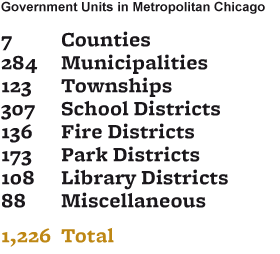One community, or even a single level of government, cannot solve our most pressing problems alone. Though northeastern Illinois is a large and diverse region, our communities are interdependent and our leaders will have to work across geographic borders to create sustainable prosperity.
A Regional Approach
Metropolitan regions drive the U.S. economy, yet state governments make most of the decisions about investing federal dollars. States too often spread those resources around too thinly, which undermines the ability of regions to implement plans no matter how well-conceived. To harness the economic power of regions like ours, the federal government should invest more in metropolitan areas and give them more authority to decide how to use those funds. Such a regional approach could focus federal investments to maximize their economic impact.
Guiding Investment Decisions
GO TO 2040 connects policy areas that have long existed in separate "silos." To implement the plan, the barriers between federal and state programs must be dismantled to help ensure they respond to the needs of communities instead of bureaucratic systems. Agencies should work together to streamline grant requirements and to align their goals, performance criteria, and funding. By making collaboration across federal and state programs routine, agencies can help regions to more effectively implement comprehensive solutions to their problems.
Increasing Efficiencies
Government agencies also need to operate more efficiently.
Accounts of wasteful and duplicative government spending, whether real or perceived, are common. The unintended consequences of outdated policies and bureaucracies include higher government costs and less accountability. To avoid these unwanted outcomes, local governments in our region should rethink and realign their policies, programs, funding, and regulations. With over 1,200 different units of government providing services to residents, businesses, and visitors of our seven-county region, increasing efficiency depends on better coordination, communication, and where appropriate, consolidation of services.

